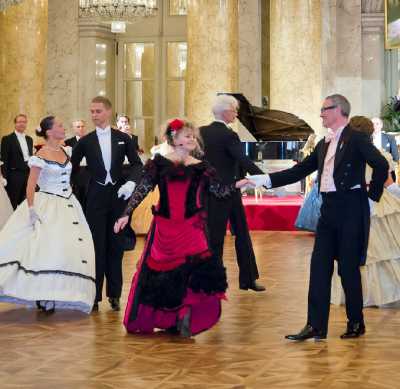Balltanz 19. Jahrhundert - Ballroom dances of the 19th century: Redowa & Polka Redowa
Im 19. Jahrhundert liebten es die Tanzlehrer, besonders schöne Volkstänze auf eine galante Weise in den Ballsaal zu adaptieren. So kam in der ersten Hälfte des 19. Jhds. die Mazurka in die europäischen Ballsäle, gern getanzt in ihrer polnischen Ursprungsart aus dem Kreis heraus mit Vortänzern und freien, fantasiereichen Touren oder nun neu in Paris und Wien als Quadrille mit meist 5 Figurentänzen. Seit etwa 1829 wurde ein Volkstanz erwähnt mit dem Namen Rèjdowák, der in die Prager Ballsäle Einzug hielt. Im Jahr 1835 beschreibt der deutsche Tanzlehrer J.G. Häcker eine Rejdouva, getanzt im ¾ Takt zu böhmischer Musik. In den 40-er Jahren des 19. Jhds. fanden insbesondere die französischen Tanzlehrer neben der Polka auch an der Rejdowa Gefallen. So wurde die „La Redowa“ und der „Redowa valse“ 1845 in Paris in den Ballsaal eingeführt, in London im Jahr 1846 durch Mr. Coulon. Etwa 10 Jahre später hat man die Polka Redowa veröffentlicht. Schnell begeisterten diese neuen Tänze die Gesellschaft in Europa, in Nordamerika und in Australien.
In welchen Figuren der Böhmische Volkstanz mit seiner Hin- und Her- Bewegung, Verfolgung und Drehung sich in der Ballsaalversion der Redowa wieder findet und wie der Mazurkaschritt Pas des basque in den Redowa Walzer kommt, was in der Polka Redowa die Polka und die Redowa bedeuten, dies vermittelt der Tanzkurs mit einem ausführlichen Unterricht in den Paartänzen Redowa und Polka Redowa als Rundtanz sowie als Quadrille.
~~~
The dancing masters in the 19th century enjoyed adapting beautiful folk dances for ballroom. Thus, in the first half of the century the mazurka appeared on the dance floor. It was danced either in the original Polish way on a big circle with freestyle figures by individual couples or, particularly in Paris and Vienna, as a quadrille, usually with 5 figures. From about 1829 is mentioned another dance, called rejdovák, which appeared first in Prague. In 1835 the dancing master J.G. Häcker describes a rejdouva, which was danced in the three four rhythm to Czech tunes. In the forties of the 19th century it was particularly the French dancing masters who, next to polka, fell in love with rejdowa. “La Redowa” and “Redowa Valse” was first introduced in 1845 in the Paris ballrooms, and a year later by Mr. Coulon in London. About ten years later appeared Polka Redowa, which spread quickly throughout Europe, North America and Australia.
The course will familiarise you in detail with all the movements of the ballroom version of this Czech dance. You will discover how the mazurka pas de basque step was introduced into the Redowa Waltz, and how the polka and redowa steps fit together in Polka Redowa, dancing in couples both round the room and in quadrille formation.
Tänze / Dances to be taught
Redowa & Polka Redowa
* La Redowa - Valse Bohemenne mit den Figuren Promenade, Walzer und Pursuite (Cellarius, Paris)
* Redowa Waltz und Polka Redowa gemäß internationalen Quellen seit 1835: Tänze in Links- und Rechtsdrehung gemäß Original-Quellen aus Europa, USA, Australien sowie Führungstechnik im Paartanz.
* Redowa Quadrille in 5 Figuren (Choreografie: Professor C. Brooks, Philadelphia, 1866)
* Polka Redowa Quadrille in 5 Figuren (Choreografie: Howe, 1858)
Tänze zur Winter- und Adventszeit
* Christmas Anglaise als Triplet – nun in 2016 in voller Länge mit ihren 4 Figuren - 1. bis 4. Advent - unterrichtet (Choreografie: Adam Rabel, Wien, um 1850). Die 4. Figur mit „Jingle Bells“ ist bereits seit 2010 ein „Kulttanz“ auf den Bällen zur „Kaiserlichen Weihnacht“ in Dresden.
Tänze zum „Thé dansant“
* Zum Tanztee genießen wir neben den erlernten Tänzen einfache, kleine Balltänze wie den Schneeballtanz und die Eiskönigin Tempête.
~~~
Redowa & Polka Redowa
* La Redowa - Valse Bohemienne consisting of 3 figures: the Promenade, the Waltz and the Chase (Cellarius, Paris)
* Redowa Waltz und Polka Redowa reconstructed from various international sources from Europe, USA and Australia 1835 onwards: danced with movements in natural and reverse turning. As well, lead technique in couple dancing will be practised.
* Redowa Quadrille in 5 Figures (Choreography: Professor C. Brooks, Philadelphia, 1866)
* Polka Redowa Quadrille in 5 Figures (Choreography: Howe, 1858)
Dances for Winter and Advent Season
* Christmas Anglaise in triplet formation – this year taught in its full length with all four figures (Choreography: Adam Rabel, Wien, around 1850). The 4th figure with „Jingle Bells“ has become the „old time favourite“ on all the Imperial Christmas Balls in Dresden since 2010.
Dances for the „Thé dansant“
* At the Saturday Tea Dance we shall enjoy, in addition to the learnt dances, some charming little pieces, like Snow Ball dance and Ice Queen Tempête.
Kurszeiten / Course Timetable
Donnerstag Kurs 01.12.2016 09:00 bis 17:30 Uhr
Freitag Kurs 02.12.2016 09:00 bis 17:30 Uhr
Sonnabend Kurs 03.12.2016 09:00 bis 12:00 Uhr
Sonnabend Video zu gelehrten Tänzen 03.12.2016 12:00 bis 13:30 Uhr
Sonnabend Thé dansant 03.12.2016 15:00 bis 19:00 Uhr
~~~
Thursday dance lessons 1.12.2016 9 am to 5.30 pm
Friday dance lessons 2.12.2016 9 am to 5.30 pm
Saturday dance lessons 3.12.2016 9 am to 12 pm
Saturday video recording of learnt dances 12 pm to 1.30 pm
Saturday Thé Dansant 3 pm to 7 pm
The course will conclude with a Tea Dance (no ball costumes should be worn, please) in the dance school, with live music. Tea, coffee and petit four refreshments will be offered.
Kursort & Tanzsaal / Dance Venue
Tanzsaal im Tanzstudio „Tres Tangos“
Dornblüthstraße 16, 01277 Dresden
http://www.tres-tangos.de
Weitere Kursinformationen in Deutsch
More informationen about the dance course in English
Website von Sylvia: www.creanc.com
| Attachment | Size |
|---|---|
| 112.48 KB | |
| 111.73 KB |
